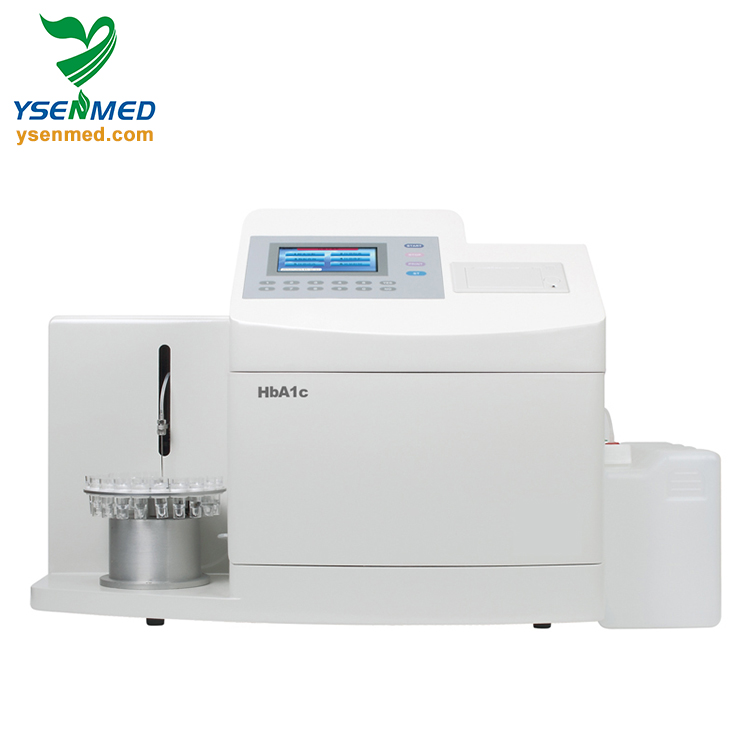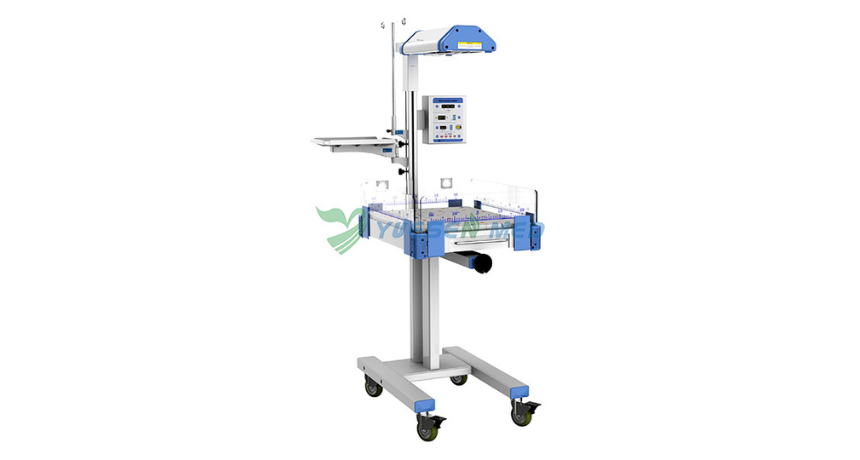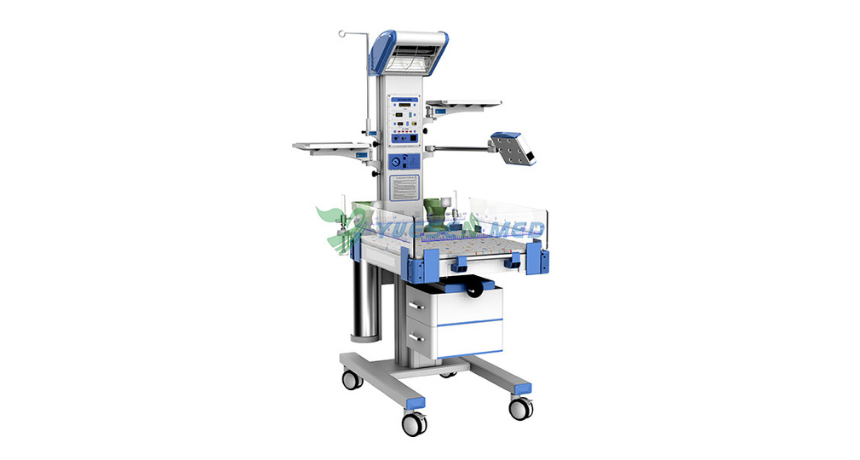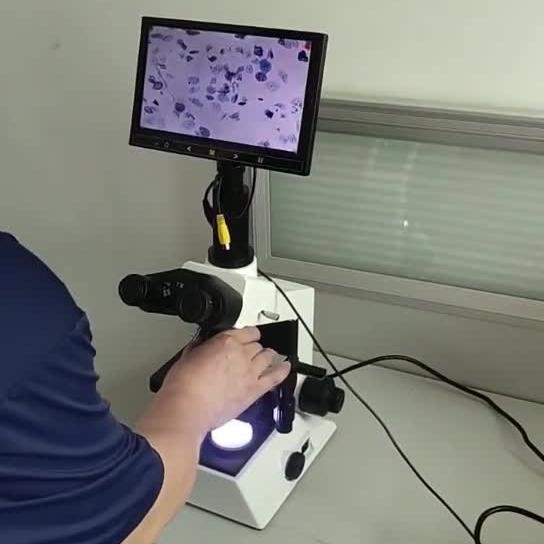Hot Products
YSX500D 50kW DR system set up and put into service in Cambodia.
YSENMED YSX500D 50kW digital x-ray system has been successfully set up and put into service in a hospital in Cambodia.
YSX056-PE serving as a vehicle-mounted x-ray in the Philippines
YSX056-PE 5.6kW portable x-ray unit has been adapted to fit on a truck, to provide mobile x-ray examination service for remote communities in the Philippines.
X Ray Machine To Zimbabwe
x ray machine, 50KW x ray machine
Microscope To Malawi
Achromatic objectives: 4X、10X、40X(S), 100X(S、Oil) Wide field eyepiece: WF10X(WF16X for option) Eyepiece head: Sliding binocular head inclined at 45° Stage: Double layer mechanical stage size 140X140mm, moving range 75X45mm Focusing: Coaxial coarse and
Fully Auto Glycated Hemoglobin Analyzers: Streamlining Diabetes Care in Labs
Views : 1103
Update time : 2024-10-30 16:33:00
Diabetes is a chronic condition that affects millions of people worldwide. Managing it effectively requires regular monitoring of blood sugar levels, and one of the most crucial tests in this process is the glycated hemoglobin (HbA1c) test. In recent years, fully automated glycated hemoglobin analyzers have revolutionized how labs conduct these tests, making the process faster, more accurate, and more efficient. In this article, we'll explore the ins and outs of these analyzers, their benefits, and their impact on diabetes care.

What is Glycated Hemoglobin (HbA1c)?
Before diving into the world of fully automated analyzers, let's clarify what glycated hemoglobin is. HbA1c is a form of hemoglobin that is chemically linked to glucose. It reflects the average blood sugar levels over the past two to three months, making it a crucial marker for diabetes management. High levels of HbA1c indicate poor blood sugar control, which can lead to serious complications.
The Importance of HbA1c Testing in Diabetes Management
Regular HbA1c testing is vital for several reasons:
- Monitoring Long-Term Control: It provides a snapshot of how well blood sugar levels have been managed over time.
- Adjusting Treatment Plans: Results can guide healthcare providers in adjusting medications or lifestyle recommendations.
- Preventing Complications: By keeping HbA1c levels in check, patients can reduce the risk of complications such as neuropathy, nephropathy, and cardiovascular diseases.
Traditional Vs. Automated HbA1c Testing
Historically, HbA1c testing was a manual process, often involving labor-intensive procedures and a higher chance of human error. But as technology advanced, so did the methods of testing.
The Drawbacks of Traditional Methods
- Time-Consuming: Manual testing can take a significant amount of time, delaying results.
- Inconsistency: Human error can lead to variability in results.
- Limited Throughput: Labs could only process a limited number of samples at a time.
Enter Fully Automated Glycated Hemoglobin Analyzers
Fully automated analyzers have transformed this landscape. They are designed to handle multiple samples simultaneously, providing quick and reliable results without the risk of human error.
How Do Fully Automated HbA1c Analyzers Work?
These analyzers utilize advanced technologies to measure HbA1c levels accurately. Here's a simplified breakdown of the process:
1. Sample Collection: Blood samples are collected and prepared for analysis.
2. Automated Processing: The analyzer automatically processes the samples, measuring the percentage of HbA1c.
3. Result Generation: Results are generated quickly and can be printed or sent electronically to healthcare providers.
Key Features of Fully Automated Analyzers
Let's take a closer look at some of the standout features of these analyzers that make them a game-changer in diabetes care:
1. High Throughput
These machines can analyze dozens of samples in a short period, making them ideal for busy labs.
2. Accuracy and Precision
Automated analyzers are designed to minimize variability, ensuring that results are consistent and reliable.
3. User-Friendly Interface
Most fully automated analyzers come with intuitive interfaces, allowing lab technicians to operate them with minimal training.
4. Integration Capabilities
Many of these devices can be integrated with laboratory information systems (LIS), streamlining data management and reporting.
5. Quality Control Features
Automated analyzers often include built-in quality control measures to ensure that results are accurate and meet regulatory standards.
Benefits of Fully Automated HbA1c Analyzers
The advantages of using fully automated glycated hemoglobin analyzers extend beyond just speed and accuracy. Let's explore some of the key benefits:
1. Improved Patient Care
With quicker turnaround times, healthcare providers can make timely decisions regarding patient treatment plans.
2. Cost-Effectiveness
While the initial investment in automated analyzers can be high, the long-term savings from reduced labor costs and fewer errors can be significant.
3. Enhanced Workflow Efficiency
Automation reduces the workload on lab staff, allowing them to focus on other critical tasks.
4. Better Data Management
Integration with LIS means that data can be managed more effectively, reducing the risk of lost results or miscommunication.
5. Increased Patient Satisfaction
Faster results lead to quicker consultations and treatment adjustments, improving overall patient satisfaction.
Challenges and Considerations
While the benefits are clear, there are some challenges and considerations to keep in mind:
1. Initial Costs
The upfront investment can be significant, which may be a barrier for smaller labs.
2. Maintenance and Calibration
Regular maintenance and calibration are necessary to ensure accuracy, which can incur additional costs.
3. Training Requirements
While user-friendly, staff still need proper training to operate these machines effectively.
The Future of HbA1c Testing
As technology continues to evolve, the future of HbA1c testing looks bright. Innovations such as point-of-care testing and telemedicine are emerging, allowing for even more accessible diabetes management.
1. Point-of-Care Testing
Imagine being able to get your HbA1c results during a routine doctor's visit without having to wait for days. Point-of-care testing is making this a reality, providing immediate feedback to both patients and healthcare providers.
2. Integration with Wearable Technology
With the rise of wearable devices that monitor blood glucose levels continuously, integrating HbA1c testing with these technologies could provide a comprehensive view of a patient's diabetes management.
Conclusion
Fully automated glycated hemoglobin analyzers are revolutionizing diabetes care in labs, offering speed, accuracy, and efficiency. As these technologies continue to develop, they promise to enhance patient care, streamline laboratory processes, and ultimately improve the quality of life for those living with diabetes. By embracing these advancements, healthcare providers can ensure that they are equipped to meet the growing challenges of diabetes management in the modern world. So, whether you're a healthcare professional or a patient, understanding these tools is essential for navigating the future of diabetes care.
FAQ
What is the purpose of the HbA1c test?
The HbA1c test measures the average blood glucose levels over the past two to three months. It helps healthcare providers assess how well a patient’s diabetes is being managed. This test is crucial for adjusting treatment plans and preventing complications associated with poorly controlled diabetes.
Are fully automated HbA1c analyzers more accurate than traditional methods?
Yes, fully automated HbA1c analyzers tend to be more accurate and reliable than traditional manual methods. They minimize human error, reduce variability in results, and provide quicker turnaround times, which enhances overall patient care.
What factors can affect my HbA1c results?
Several factors can influence HbA1c levels, including recent illnesses, changes in diet, medications, and certain medical conditions like anemia or kidney disease. It's important to discuss any significant changes or health issues with your healthcare provider, as these could impact the accuracy of your results.

What is Glycated Hemoglobin (HbA1c)?
Before diving into the world of fully automated analyzers, let's clarify what glycated hemoglobin is. HbA1c is a form of hemoglobin that is chemically linked to glucose. It reflects the average blood sugar levels over the past two to three months, making it a crucial marker for diabetes management. High levels of HbA1c indicate poor blood sugar control, which can lead to serious complications.
The Importance of HbA1c Testing in Diabetes Management
Regular HbA1c testing is vital for several reasons:
- Monitoring Long-Term Control: It provides a snapshot of how well blood sugar levels have been managed over time.
- Adjusting Treatment Plans: Results can guide healthcare providers in adjusting medications or lifestyle recommendations.
- Preventing Complications: By keeping HbA1c levels in check, patients can reduce the risk of complications such as neuropathy, nephropathy, and cardiovascular diseases.
Traditional Vs. Automated HbA1c Testing
Historically, HbA1c testing was a manual process, often involving labor-intensive procedures and a higher chance of human error. But as technology advanced, so did the methods of testing.
The Drawbacks of Traditional Methods
- Time-Consuming: Manual testing can take a significant amount of time, delaying results.
- Inconsistency: Human error can lead to variability in results.
- Limited Throughput: Labs could only process a limited number of samples at a time.
Enter Fully Automated Glycated Hemoglobin Analyzers
Fully automated analyzers have transformed this landscape. They are designed to handle multiple samples simultaneously, providing quick and reliable results without the risk of human error.
How Do Fully Automated HbA1c Analyzers Work?
These analyzers utilize advanced technologies to measure HbA1c levels accurately. Here's a simplified breakdown of the process:
1. Sample Collection: Blood samples are collected and prepared for analysis.
2. Automated Processing: The analyzer automatically processes the samples, measuring the percentage of HbA1c.
3. Result Generation: Results are generated quickly and can be printed or sent electronically to healthcare providers.
Key Features of Fully Automated Analyzers
Let's take a closer look at some of the standout features of these analyzers that make them a game-changer in diabetes care:
1. High Throughput
These machines can analyze dozens of samples in a short period, making them ideal for busy labs.
2. Accuracy and Precision
Automated analyzers are designed to minimize variability, ensuring that results are consistent and reliable.
3. User-Friendly Interface
Most fully automated analyzers come with intuitive interfaces, allowing lab technicians to operate them with minimal training.
4. Integration Capabilities
Many of these devices can be integrated with laboratory information systems (LIS), streamlining data management and reporting.
5. Quality Control Features
Automated analyzers often include built-in quality control measures to ensure that results are accurate and meet regulatory standards.
Benefits of Fully Automated HbA1c Analyzers
The advantages of using fully automated glycated hemoglobin analyzers extend beyond just speed and accuracy. Let's explore some of the key benefits:
1. Improved Patient Care
With quicker turnaround times, healthcare providers can make timely decisions regarding patient treatment plans.
2. Cost-Effectiveness
While the initial investment in automated analyzers can be high, the long-term savings from reduced labor costs and fewer errors can be significant.
3. Enhanced Workflow Efficiency
Automation reduces the workload on lab staff, allowing them to focus on other critical tasks.
4. Better Data Management
Integration with LIS means that data can be managed more effectively, reducing the risk of lost results or miscommunication.
5. Increased Patient Satisfaction
Faster results lead to quicker consultations and treatment adjustments, improving overall patient satisfaction.
Challenges and Considerations
While the benefits are clear, there are some challenges and considerations to keep in mind:
1. Initial Costs
The upfront investment can be significant, which may be a barrier for smaller labs.
2. Maintenance and Calibration
Regular maintenance and calibration are necessary to ensure accuracy, which can incur additional costs.
3. Training Requirements
While user-friendly, staff still need proper training to operate these machines effectively.
The Future of HbA1c Testing
As technology continues to evolve, the future of HbA1c testing looks bright. Innovations such as point-of-care testing and telemedicine are emerging, allowing for even more accessible diabetes management.
1. Point-of-Care Testing
Imagine being able to get your HbA1c results during a routine doctor's visit without having to wait for days. Point-of-care testing is making this a reality, providing immediate feedback to both patients and healthcare providers.
2. Integration with Wearable Technology
With the rise of wearable devices that monitor blood glucose levels continuously, integrating HbA1c testing with these technologies could provide a comprehensive view of a patient's diabetes management.
Conclusion
Fully automated glycated hemoglobin analyzers are revolutionizing diabetes care in labs, offering speed, accuracy, and efficiency. As these technologies continue to develop, they promise to enhance patient care, streamline laboratory processes, and ultimately improve the quality of life for those living with diabetes. By embracing these advancements, healthcare providers can ensure that they are equipped to meet the growing challenges of diabetes management in the modern world. So, whether you're a healthcare professional or a patient, understanding these tools is essential for navigating the future of diabetes care.
FAQ
What is the purpose of the HbA1c test?
The HbA1c test measures the average blood glucose levels over the past two to three months. It helps healthcare providers assess how well a patient’s diabetes is being managed. This test is crucial for adjusting treatment plans and preventing complications associated with poorly controlled diabetes.
Are fully automated HbA1c analyzers more accurate than traditional methods?
Yes, fully automated HbA1c analyzers tend to be more accurate and reliable than traditional manual methods. They minimize human error, reduce variability in results, and provide quicker turnaround times, which enhances overall patient care.
What factors can affect my HbA1c results?
Several factors can influence HbA1c levels, including recent illnesses, changes in diet, medications, and certain medical conditions like anemia or kidney disease. It's important to discuss any significant changes or health issues with your healthcare provider, as these could impact the accuracy of your results.
Related News
Read More >>
 Is an Infant Radiant Warmer Good for Babies' Health?
Is an Infant Radiant Warmer Good for Babies' Health?
Apr .13.2025
What exactly is the infant radiant warmer, and how does it contribute to a baby's health? Let's dive into this topic and explore the ins and outs of infant radiant warmers.
 What is an Infant Radiant Warmer?
What is an Infant Radiant Warmer?
Apr .12.2025
One of the unsung heroes in neonatal care is the infant radiant warmer. But what exactly is it? Let's dive into the world of infant care and explore the ins and outs of this vital device.
 Introduction video of YSENMED YSXWJ-BX301B Digital Biological Microscope.
Introduction video of YSENMED YSXWJ-BX301B Digital Biological Microscope.
Apr .01.2025
Here we share the introduction video of YSENMED YSXWJ-BX301B Digital Biological Microscope.
 YSDR-VET320 veterinary DR & YSB-DU10V color ultrasound serving well in Kiram Veterinary Surgery in Uganda
YSDR-VET320 veterinary DR & YSB-DU10V color ultrasound serving well in Kiram Veterinary Surgery in Uganda
Mar .31.2025
Kiram Veterinary Surgery in Uganda shares the clear images they have got from YSDR-VET320 veterinary digital x-ray system and YSB-DU10V vet color ultrasound machine.



